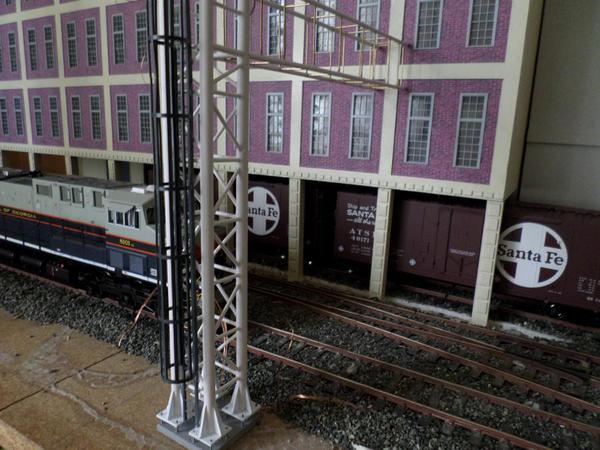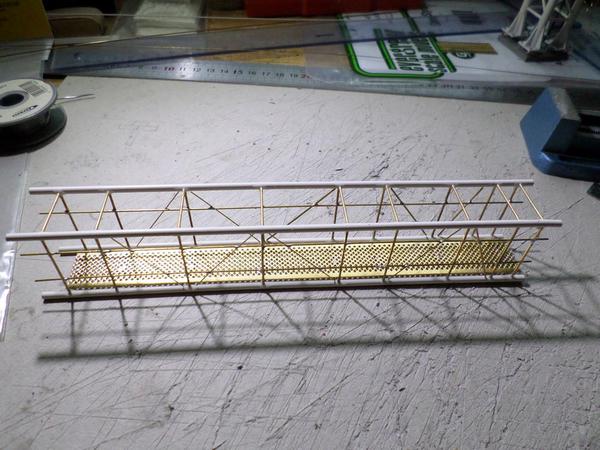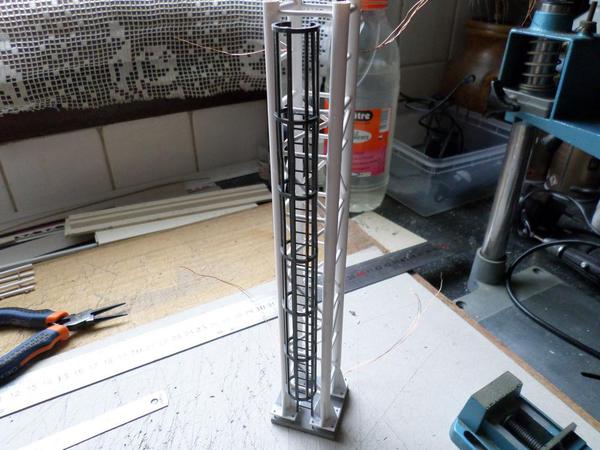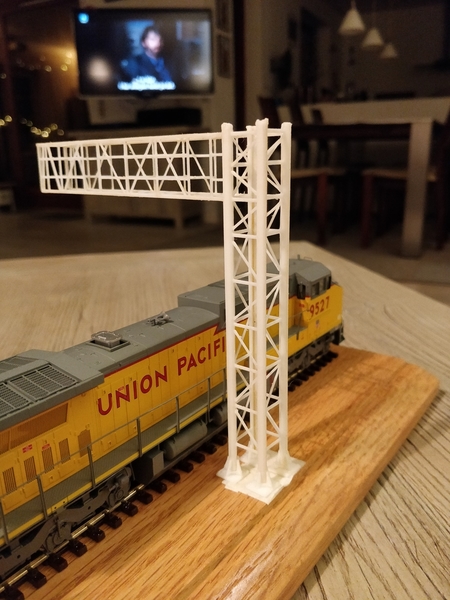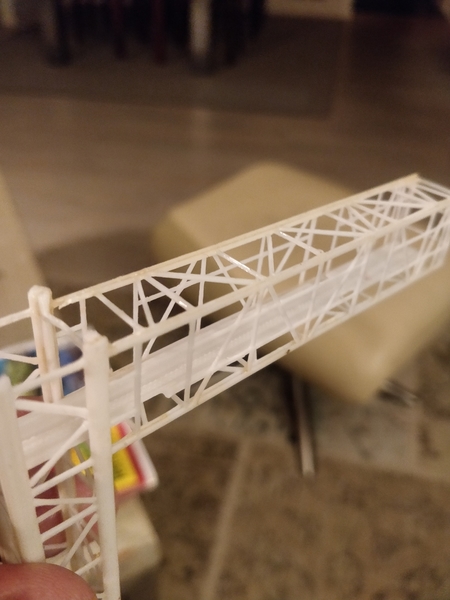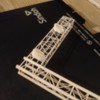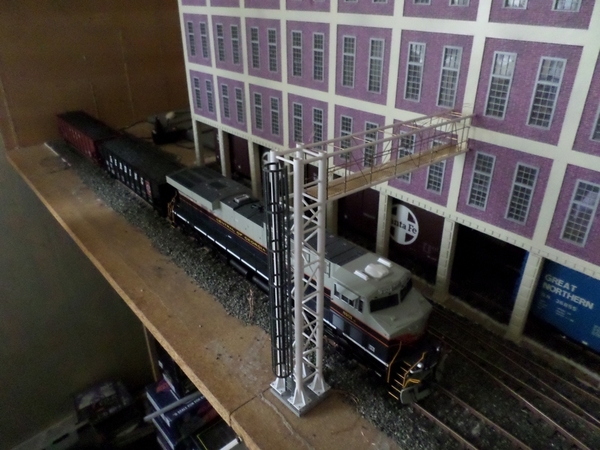Good luck on the search. I've got a set of that Plastruct protected ladder that may end up on the distillery silos. I agree, it may be a bit oversized, but what's the alternative? I don't relish the thought of making the ladder cage out of brass.
News of the cantilever:
I received what I ordered and could keep on.
Today, the horizontal part with the walkway and brass wires to reinforce all this part. it's really my first attempt in soldering!!!!!I was anxious to do this!!!now it's done! phew!!!
Attachments
Looking great! There's nothing to be scared off in soldering. A few things to keep in mind:
1. Parts need to metallurgically clean. If there's a lot of oxide on the surface, mechanically get it off before adding flux.
2. Flux (whether in the solder or added separately) removes the remaining oxide and prevents oxygen from getting into the heated joint thereby preventing the creation of more oxide.
3. Solder flows to the heat, therefore, place your heat source on the opposite side of the joint from the solder you're applying.
4. Less solder is better than more. The strength of the joint is the amalgam that forms when liquid solder actually dissolves into the substrate's surface. If it's a good joint, very little solder is actually needed. If it's not a good joint excess solder adds no strength and hides whether it's a good joint in the first place.
5. When you inspect your work, the solder should form a concave curve where it touches the joint. If it is convex (bulging out), it means that the solder's surface tension is greater than the attraction to the substrate and it's a poor joint.
6. Use a heat source with sufficient power to heat the joint quickly. The longer it takes to heat the joint, the more opportunity there is to form oxides, which further prevents good heat flow, and things go downhill from there.
That's it! This is one subject I know lots about. I trained over 2,000 people on how to do it.
Thanks, TM. I must have made millions of soldered joints and that's the best explanation I've seen. ![]()
Cheers
Wow, that's a very good write up on preparing for soldering. I have never read anything like that.
I have burned some liquid paste with too much heat trying to make up for the surface not being prepared correctly! It's like painting a car. Painting is 1/100 of the job. 99% is in the prep. Skip it, and you'll pay.
Thanks fellows! I had the cover story about soldering in the February 2002 issue of Classic Toy Trains. I wrote that article while living in Germany and soldering the power leads to my Ross track.
Painting's problem is similar except even worse in soldering. Paint adheres to a surface in a purely mechanical way. That's why paint is better on a surface that's matte and has some "tooth". Solder actually dissolves into the surface chemically. If you look at a micrograph of a soldered connection, you actually see the solder alloy penetrating the crystal structure of the substrate. It's why it's so dog-gone hard to solder aluminum or stainless steel. They both have very hard oxide surfaces which is why they don't rust. They're already pre-rusted.
Mechanical soldering and electrical soldering are essentially the same. In both cases the smallest quantity of solder needed to fully enclose the joint is all that's needed. Any more is counterproductive.
The vertical part is finished (painting comes later); I find the caged ladder a little too oversized, but I have not found another model than the one from Plastruct!
I built from scratch, to what I assumed was the average size diameter of a ladder cage. After completion, I also thought it looked over sized. Otherwise, crude as the cage is, IMO the old Plasticville signal bridge looked pretty sparse without it.
Thanks for sharing your advices and opinions.
For the oversize off the caged ladder, it's perhaps also an optical effect because the ladder is black and the poles are white...I am sure that the contrast will be less important after painting all in the same colour!
Looking great! There's nothing to be scared off in soldering. A few things to keep in mind:
1. Parts need to metallurgically clean. If there's a lot of oxide on the surface, mechanically get it off before adding flux.
2. Flux (whether in the solder or added separately) removes the remaining oxide and prevents oxygen from getting into the heated joint thereby preventing the creation of more oxide.
3. Solder flows to the heat, therefore, place your heat source on the opposite side of the joint from the solder you're applying.
4. Less solder is better than more. The strength of the joint is the amalgam that forms when liquid solder actually dissolves into the substrate's surface. If it's a good joint, very little solder is actually needed. If it's not a good joint excess solder adds no strength and hides whether it's a good joint in the first place.
5. When you inspect your work, the solder should form a concave curve where it touches the joint. If it is convex (bulging out), it means that the solder's surface tension is greater than the attraction to the substrate and it's a poor joint.
6. Use a heat source with sufficient power to heat the joint quickly. The longer it takes to heat the joint, the more opportunity there is to form oxides, which further prevents good heat flow, and things go downhill from there.
That's it! This is one subject I know lots about. I trained over 2,000 people on how to do it.
Hi TM
This is an excellent description. May I publish it on my forum?
Cheers
Sure... I probably should do a YouTube on it.
Thanks. I get sick of telling new members.
Your explanation hits the spot. ![]()
Cheers
Hi All
I have read this topic and have started to manufacture ( private person no company ) on my 3D, first in HO scale.
After BLMA closed in 2018 these signals are in demand, but printing them takes only time and 50cent for the material.
Will post pics later.
Best regards
Jan Nielsen, Denmark.
Waiting for your drawings and your 3D prints!
jpv in France
Great work and attention to detail on this project! Thanks for the updates
Was this printed in one-piece? And what kind of printer did it? Was it a filament printer or something else? Very intriguing. Huge possibilities!!
Hi, it was made out of 2 complete sides to have the bridge fixed to the coloum instead of glued. The other facades are glued on. Feet and subplates are then glued on. Thin white drinking-straws are glued on to draw wires through. Will be silver painted with black heads. Printer is Sindoh DP200, Filament type PLA. Nozzle 0,4mm. Glueing is a challenge, but I found a good one.
Regards
Jan.
Drawn in ACAD Inventor 3D.
That's a nice printer! Checked out the specs on Amazon.




